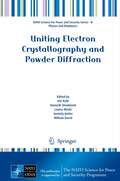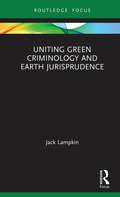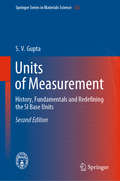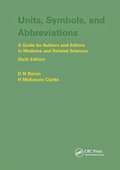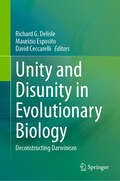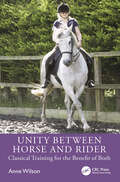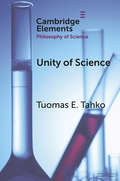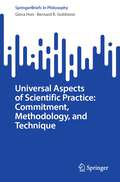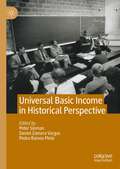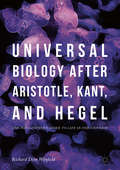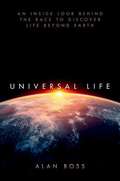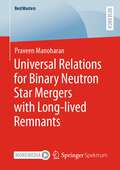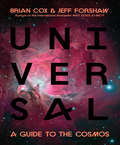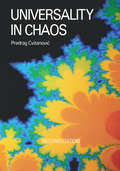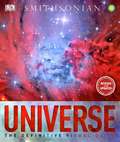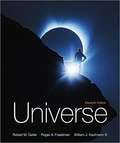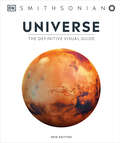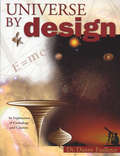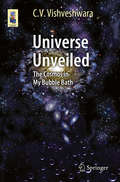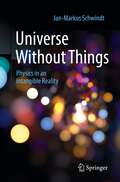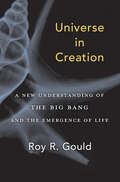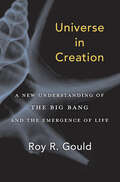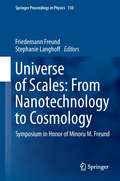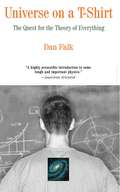- Table View
- List View
Uniting Electron Crystallography and Powder Diffraction
by Anatoly Avilov Kenneth Shankland Louisa Meshi Ute Kolb William I.F DavidThe polycrystalline and nanocrystalline states play an increasingly important role in exploiting the properties of materials, encompassing applications as diverse as pharmaceuticals, catalysts, solar cells and energy storage. A knowledge of the three-dimensional atomic and molecular structure of materials is essential for understanding and controlling their properties, yet traditional single-crystal X-ray diffraction methods lose their power when only polycrystalline and nanocrystalline samples are available. It is here that powder diffraction and single-crystal electron diffraction techniques take over, substantially extending the range of applicability of the crystallographic principles of structure determination. This volume, a collection of teaching contributions presented at the Crystallographic Course in Erice in 2011, clearly describes the fundamentals and the state-of-the-art of powder diffraction and electron diffraction methods in materials characterisation, encompassing a diverse range of disciplines and materials stretching from archeometry to zeolites. As such, it is a comprehensive and valuable resource for those wishing to gain an understanding of the broad applicability of these two rapidly developing fields.
Uniting Green Criminology and Earth Jurisprudence
by Jack LampkinAs planet Earth continues to absorb unprecedented levels of anthropogenically induced environmental and climatic change, two similar academic schools of thought have emerged in recent years, both making sustained efforts to explain how and why this state of affairs has evolved. These two disciplines are known as green criminology and earth jurisprudence. Whilst these areas of study can be seen as sub-disciplines of their parent subjects, law and criminology, this book proposes that much can be achieved by authors uniting and collaborating on their academic work. By doing this, it is argued that green criminology stands to benefit from a discipline that places mother nature at the heart of lawmaking and therefore providing a solution to the environmental harms identified by green criminologists. Furthermore, earth jurisprudence will profit from utilising the breadth of academic work produced within the green criminology academic arena. Therefore, this book seeks to unite green criminology and earth jurisprudence in an effort to find solutions to the extraordinary environmental problems that the world now faces.
Units of Measurement: History, Fundamentals and Redefining the SI Base Units (Springer Series in Materials Science #122)
by S. V. GuptaThis book delivers a comprehensive overview of units of measurement. Beginning with a historical look at metrology in Ancient India, the book explains fundamental concepts in metrology such as basic, derived and dimensionless quantities, and introduces the concept of quantity calculus. It discusses and critically examines various three and four-dimensional systems of units used both presently and in the past, while explaining why only four base units are needed for a system of measurement. It discusses the Metre Convention as well as the creation of the International Bureau of Weights and Measures, and gives a detailed look at the evolution of the current SI base units of time, length, mass, electric current, temperature, intensity of illumination and substance.This updated second edition is extended with timely new chapters discussing past efforts to redefine the SI base units as well as the most recent 2019 redefinitions based entirely on the speed of light and other fundamental physical constants. Additionally, it provides biographical presentations of many of the historical figures behind commonly used units of measurements, such as Newton, Joule and Ohm, With its accessible and comprehensive treatment of the field, together with its unique presentation of the underlying history, this book is well suited to any student and researcher interested in the practical and historical aspects of the field of metrology.
Units, Symbols, and Abbreviations: A Guide for Authors and Editors in Medicine and Related Sciences, Sixth edition
by Denis Baron H.M. ClarkeNow in its sixth edition, this guide sets out international and standard practice and is an invaluable reference for medical and scientific editors and authors. Scholarly journals often quote this booklet as a guide in their instructions to authors.An invaluable reference for editors and authors. Includes fully updated sections on metrication and SI units, symbols and nomenclature, layout of references and proof correction.
Unity and Disunity in Evolutionary Biology: Deconstructing Darwinism
by Richard G. Delisle Maurizio Esposito David CeccarelliIt is not uncommon to see in major areas of research concerned with science that historical studies are accompanied by the rise of complementary or contradictory historiographies. With time, it seems, scholars discover new approaches to study topics, thus questioning old concepts, traditions, periodizations and historical labels. Apparently, this has not been the case in evolutionary thought. In that area, the main historiographic labels such as Darwinian Revolution, Eclipse of Darwinism, and Modern Synthesis have been in place and largely uncontested for about 50 years. Such labels seem to work as irrefutable, and often hidden, premises of many historical reconstructions, philosophical analyses, and scientific conceptualizations. This volume aims to move beyond this state of affair, opening new thinking avenues by revisiting the traditional historiography and laying the groundwork for establishing a “new historiography” that considers the intertwined threads that compose evolutionary biology. Notably, evolutionary studies seem to have been marked by the tension between unification attempts and the proliferation of approaches, methodologies, and styles of thinking. As the contributors to this volume illustrate, research traditions branched off throughout the history of evolutionary thought, before and after Charles Darwin. The resulting complexity challenges traditional thinking categories, throwing a somewhat different light on a more recent label like the Extended Evolutionary Synthesis. More than 40 years after the now classic, The Evolutionary Synthesis: Perspectives on the Unification of Biology (1980), edited by Ernst Mayr and William Provine, the contributors to this volume aim to reevaluate where evolutionary biology stands today.
Unity between Horse and Rider: Classical Training for the Benefit of Both
by Anne WilsonMany riders and horse owners are looking for a kinder, more ethical way of interacting with their horses, to fulfil the requirements of the modern Social Licence to Operate but also to enhance their relationship with their animal. In this book, author and expert rider Anne Wilson demonstrates that we need look no further than the teachings of the great classical riding masters, past and present.Classical teachings are often misunderstood today. This in-depth book on classical principles aims to rectify that, enlightening the reader on techniques which will enhance their own enjoyment as well as that of their horses. Wilson provides a wealth of ‘how-to’ information, via down-to-earth language and detailed imagery, which will enable readers to put the principles into effect. She throws light on hitherto much misunderstood aspects of horse training, showing that when these principles are employed correctly, the rider or trainer will experience an incomparable feeling of being at one with their horse. Perhaps most importantly, this book will help your horse enjoy ‘dancing’ with his or her rider, enhancing their physical and mental well-being, as well as their likely longevity.Unity between Horse and Rider: Classical Training for the Benefit of Both will be of great benefit to riders in any discipline who have basic knowledge and skills but wish to learn a more ethical, fulfilling way of training and riding. For riders, riding professionals, students and trainers, classical riding is the key to a happy life for horse and human alike.
Unity of Science (Elements in the Philosophy of Science)
by Tuomas E. TahkoUnity of science was once a very popular idea among both philosophers and scientists. But it has fallen out of fashion, largely because of its association with reductionism and the challenge from multiple realisation. Pluralism and the disunity of science are the new norm, and higher-level natural kinds and special science laws are considered to have an important role in scientific practice. What kind of reductionism does multiple realisability challenge? What does it take to reduce one phenomenon to another? How do we determine which kinds are natural? What is the ontological basis of unity? In this Element, Tuomas Tahko examines these questions from a contemporary perspective, after a historical overview. The upshot is that there is still value in the idea of a unity of science. We can combine a modest sense of unity with pluralism and give an ontological analysis of unity in terms of natural kind monism.
Universal Aspects of Scientific Practice: Commitment, Methodology, and Technique (SpringerBriefs in Philosophy)
by Giora Hon Bernard R. GoldsteinThis book provides a unique contribution to philosophy of science from the perspective of the practice of science. It focuses on processes that generate scientific knowledge and seeks general and universal features that characterize scientific practice; features that are inherent to the practice of science. Science is an activity, and the scientist is an agent who pursues some practice, which in one way or another engages evidence. In science, claims to knowledge are typically supported by argument that engages evidence at some point in explanation, in prediction, or indeed in any mode of presenting data and its interpretation. Thus, the practice of science includes at least three elements so that an argument can be formulated: presuppositions, modes of inference, and consequences that relate to evidence. The authors discuss in detail eight cases in chronological order with which they illustrate how commitment, methodology, and technique come into play in the practice of an individual physicist or a group of researchers in the physical sciences. Each case highlights aspects of the roles these categories play in scientific practice, where the goal is to generate and extend scientific knowledge.
Universal Basic Income in Historical Perspective
by Peter Sloman Daniel Zamora Vargas Pedro Ramos PintoThis new edited collection brings together historians and social scientists to engage with the global history of Universal Basic Income (UBI) and offer historically-rich perspectives on contemporary debates about the future of work. In particular, the book goes beyond a genealogy of a seemingly utopian idea to explore how the meaning and reception of basic income proposals has changed over time. The study of UBI provides a prism through which we can understand how different intellectual traditions, political agents, and policy problems have opened up space for new thinking about work and welfare at critical moments.Contributions range broadly across time and space, from Milton Friedman and the debate over guaranteed income in the post-war United States to the emergence of the European basic income movement in the 1980s and the politics of cash transfers in contemporary South Africa. Taken together, these chapters address comparative questions: why do proposals for a guaranteed minimum income emerge at some times and recede into the background in others? What kinds of problems is basic income designed to solve, and how have policy proposals been shaped by changing attitudes to gender roles and the boundaries of social citizenship? What role have transnational networks played in carrying UBI proposals between the global north and the global south, and how does the politics of basic income vary between these contexts?In short, the book builds on a growing body of scholarship on UBI and lays the groundwork for a much richer understanding of the history of this radical proposal.
Universal Biology after Aristotle, Kant, and Hegel: The Philosopher's Guide To Life In The Universe
by Richard Dien WinfieldHere is a universal biology that draws upon the contributions of Aristotle, Kant, and Hegel to unravel the mystery of life and conceive what is essential to living things anywhere they may arise. The book develops a philosopher’s guide to life in the universe, conceiving how nature becomes a biosphere in which life can emerge, what are the basic life processes common to any organism, how evolution can give rise to the different possible forms of life, and what distinguishes the essential life forms from one another.
Universal Life: An Inside Look Behind the Race to Discover Life Beyond Earth
by Alan BossBoss is the Chair of NASA's Exoplanet Exploration Program Analysis Group, and was also on the Kepler Mission science team. Kepler proved that essentially every star in the night sky has a planetary system, and that most of these systems contain a habitable world, potentially capable of evolving and supporting life.
Universal Relations for Binary Neutron Star Mergers with Long-lived Remnants (BestMasters)
by Praveen ManoharanIn the last 25 years, an extensive body of work has developed various equation of state independent - or (approximately) universal - relations that allow for the inference of neutron star parameters from gravitational wave observations. These works, however, have mostly been focused on singular neutron stars, while our observational efforts at the present, and in the near future, will be focused on binary neutron star (BNS) mergers. In light of these circumstances, the last five years have also given rise to more attempts at developing universal relations that relate BNS pre-merger neutron stars to stellar parameters of the post-merger object, mostly driven by numerical relativity simulations. In this thesis a first attempt at perturbatively deriving universal relations for binary neutron star mergers with long-lived neutron star remnants is presented. The author succeeds in confirming previous results relating pre-merger binary tidal deformabilities to the f-mode frequency of the post-merger object. Combining this result with recent advances of computing the f-mode frequency of fast rotating neutron stars, he also derives a combined relation that relates the pre-merger binary tidal deformability of a BNS to the effective compactness of a long-lived neutron star remnant. Finally, he also proposes a direct relation between these quantities with improved accuracy.
Universal: A Guide to the Cosmos
by Brian Cox Jeff ForshawAn awe-inspiring, unforgettable journey of scientific exploration from Brian Cox and Jeff Forshaw, the international bestselling authors of Why Does E=MC2? and The Quantum Universe, with 55 black-&-white and 45 full-color pages featuring photographs, diagrams, maps, tables, and graphsWe dare to imagine a time before the Big Bang, when the entire universe was compressed into a space smaller than an atom. And now, as Brian Cox and Jeff Forshaw show, we can do more than imagine: we can understand.Universal takes us on an epic journey of scientific exploration. It reveals how we can all come to grips with some of the most fundamental questions about our Earth, Sun, and solar system--and the star-filled galaxies beyond. How big is our solar system? How quickly is space expanding? How big is the universe? What is it made of? Some of these questions can be answered on the basis of observations you can make in your own backyard. Other answers draw on the astonishing information now being gathered by teams of astronomers operating at the frontiers of the known universe.At the heart of all this lies the scientific method. Science reveals a deeper beauty and connects us to each other, to our world, and to our universe. Science reaches out into the unknown. As Universal demonstrates, if we dare to imagine, we can do the same.
Universality in Chaos, 2nd edition
by Predrag CvitanovićNature provides many examples of physical systems that are described by deterministic equations of motion, but that nevertheless exhibit nonpredictable behavior. The detailed description of turbulent motions remains perhaps the outstanding unsolved problem of classical physics. In recent years, however, a new theory has been formulated that succeeds in making quantitative predictions describing certain transitions to turbulence. Its significance lies in its possible application to large classes (often very dissimilar) of nonlinear systems. Since the publication of Universality in Chaos in 1984, progress has continued to be made in our understanding of nonlinear dynamical systems and chaos. This second edition extends the collection of articles to cover recent developments in the field, including the use of statistical mechanics techniques in the study of strange sets arising in dynamics. It concentrates on the universal aspects of chaotic motions, the qualitative and quantitative predictions that apply to large classes of physical systems. Much like the previous edition, this book will be an indispensable reference for researchers and graduate students interested in chaotic dynamics in the physical, biological, and mathematical sciences as well as engineering.
Universe
by Martin ReesUniverse is divided into three main sections. (i) The Introduction is an overview of the basic concepts of astronomy; (ii) Guide to the universe looks, in turn, at the solar system, the Milky Way (our home galaxy), and the regions of space that lie beyond; and (iii) The night sky is a guide to the sky for the amateur skywatcher.
Universe
by Roger Freedman Robert Geller William KaufmannUniverse by Robert M. Geller and Roger Freedman strikes the right balance between scientific rigor, student comprehension, and excitement. Available as the full 27-chapter text or split into Stars and Galaxies and The Solar System, Universe provides all the detail you need to prepare students for engaging with astronomical ideas and theories, while also inviting students to explore through stunning visuals and relatable narratives.
Universe (DK Definitive Visual Encyclopedias)
by DKMarvel at the wonders of the universe, from stars and planets to black holes and nebulae, in this exploration of our solar system and beyond.Universe opens with a look at astronomy and the history of the Universe, using 3D artworks to provide a comprehensive grounding in the fundamental concepts of astronomy, including the basic techniques of practical astronomy.The core of the book is a tour of the cosmos covering the Solar System, the Milky Way, and galaxies beyond our own. Explanatory pages introduce different celestial phenomena, such as galaxies, and are followed by catalogs that profile the most interesting and important examples.A comprehensive star atlas completes the picture, with entries on each of the 88 constellations and a monthly sky guide showing the night sky as it appears throughout the year as viewed from both the northern and southern hemispheres.
Universe By Design
by Danny FaulknerAnd God said, Let there be lights in the firmament of the heaven to divide the day from the night; and let them be for signs, and for seasons, and for days, and years: and God saw that it was good.-Gen. 1:14-18 The universe was created with purpose and reason; and modern science with all of its experiments, exploration, and sophistication has never proven otherwise. In fact, as author Dr. Danny Faulkner makes plain, advanced science argues more for a created cosmology than a big bang. Written for the upper-level student through the well-read layman, Universe by Design explores the universe, explaining its origins and discussing the historical development of cosmology from a creationist viewpoint. Includes: Recent developments in cosmology Explanatory diagrams and illustrations Theories and facts on the origin and expansion of the universe The contributions of Ptolemy, Galileo, Brahe, Newton, Hubble, Einstein, and other famous scientists to the field Thorough discussion and problems with the big bang theory Many examples and analogies to help understand concepts of cosmology Difficulties and critiques of modern cosmology Chapter questions and answers for homeschool study As an excellent supplement to an upper-level homeschool curriculum or the library of an astronomer - amateur or advanced - this book will inform and enlighten the scientific mind.
Universe Lost: Reclaiming a Christian World View
by Stuart CookThe author draws his own personal interpretation of reality from the Bible.
Universe Unveiled
by C. V. VishveshwaraThe bubbles were swirling all around me, massaging my body. As I luxuriated in this fantastic bath, I gasped realizing that those bubbles carried with them miniature galaxies bringing the entire Cosmos into my bathtub. . . Alfie is back. And so are George and other characters from the author's previous book Einstein's Enigma or Black Holes in My Bubble Bath. While the present book, Universe Unveiled - The Cosmos in My Bubble Bath, is completely independent, its storyline can be considered a sequel to the previous one. The scientific content spanning ancient world models to the most recent mysteries of cosmology is presented in an entirely nontechnical and descriptive style through the discussions between Alfie, the enlightened learner, and George, professor of astrophysics. Fantasies, based on these discussions that cover the scientific facts, are created by the magical bubble baths taken by Alfie. Universe Unveiled blends accurate science with philosophy, drama, humour, and fantasy to create an exciting cosmic journey that reads like a novel and educates as it entertains. "Spurred by a series of mind-bending discoveries, Man's millennial love affair with the stars has now reached fever pitch. No one writing today is better positioned to evoke the romance and beauty of these cosmic discoveries than Vishveshwara. A leading expert in Einstein's relativity theory, he brings a lyrical voice and a poetic sensibility to this joyful task. Universe Unveiled, a unique literary creation, transports readers into believing they can actually hear the music of the spheres. " Professor Robert Fuller, Former President, Oberlin College (USA) Author of Somebodies and Nobodies: Overcoming the Abuse of Rank
Universe Without Things: Physics in an Intangible Reality
by Jan-Markus SchwindtPhysics is written in the language of mathematics, and its findings are based on thousands of experiments. But what kind of picture does physics paint of the world? What do theories like relativity or quantum mechanics contribute to it? How complete is this picture? This book sheds light on how the "things" these theories are about relate to our everyday things, and points out what questions remain unanswered and what problems are involved.In this book, the author presents how physics works, what it can and cannot do. In doing so, he describes the surprising answers that physics provides to many of our questions about the nature of "things" and the world; answers that challenge our intuition in many ways.This book is a translation of the original German 1st edition Universum ohne Dinge by Jan-Markus Schwindt, published by Springer-Verlag GmbH Germany, part of Springer Nature in 2020. The translation was done with the help of artificial intelligence (machine translation by the service DeepL.com). A subsequent human revision was done primarily in terms of content, so that the book will read stylistically differently from a conventional translation. Springer Nature works continuously to further the development of tools for the production of books and on the related technologies to support the authors.
Universe in Creation: A New Understanding of the Big Bang and the Emergence of Life
by Roy R. GouldWe know the universe has a history, but does it also have a story of self-creation to tell? Yes, in Roy R. Gould’s account. He offers a compelling narrative of how the universe—with no instruction other than its own laws—evolved into billions of galaxies and gave rise to life, including humans who have been trying for millennia to comprehend it. Far from being a random accident, the universe is hard at work, extracting order from chaos. Making use of the best current science, Gould turns what many assume to be true about the universe on its head. The cosmos expands inward, not outward. Gravity can drive things apart, not merely together. And the universe seems to defy entropy as it becomes more ordered, rather than the other way around. Strangest of all, the universe is exquisitely hospitable to life, despite its being constructed from undistinguished atoms and a few unexceptional rules of behavior. Universe in Creation explores whether the emergence of life, rather than being a mere cosmic afterthought, may be written into the most basic laws of nature. Offering a fresh take on what brought the world—and us—into being, Gould helps us see the universe as the master of its own creation, not tethered to a singular event but burgeoning as new space and energy continuously stream into existence. It is a very old story, as yet unfinished, with plotlines that twist and churn through infinite space and time.
Universe in Creation: A New Understanding of the Big Bang and the Emergence of Life
by Roy R. Gould“In a unique take on the cosmos, Gould makes the case that the emergence of a great many things are not only pre-ordained, but predictable.” (Forbes)We know the universe has a history, but does it also have a story of self-creation to tell? Yes, in Roy R. Gould’s account. He offers a compelling narrative of how the universe?with no instruction other than its own laws?evolved into billions of galaxies and gave rise to life. Far from being a random accident, the universe is hard at work, extracting order from chaos.Making use of the best current science, Gould turns what many assume to be true about the universe on its head. The cosmos expands inward, not outward. Gravity can drive things apart, not merely together. And the universe seems to defy entropy as it becomes more ordered, rather than the other way around. Strangest of all, the universe is exquisitely hospitable to life, despite its being constructed from undistinguished atoms and a few unexceptional rules of behavior. Universe in Creation explores whether the emergence of life, rather than being a mere cosmic afterthought, may be written into the most basic laws of nature.“A must-have for all avid popular science fans.” —Astronomy Now“Gould . . . proposes a fascinating thesis about life’s emergence in this eloquent debut” —Publishers Weekly“A joyous romp through a cosmos full of wonders.” —Roald Hoffmann, Nobel Laureate and author of Beyond the Finite“Exciting, original, and extremely well written.” —Avi Loeb, Harvard University, New York Times bestselling author of Extraterrestrial“Fascinating. . . . Gould artfully describes various . . . highlights in universal history, like the formation of stars and planets. Many of these moments are majestic.” —New Republic
Universe of Scales: From Nanotechnology to Cosmology
by Friedemann Freund Stephanie LanghoffThe presentations at this NASA-hosted Symposium in honor of Mino Freund will touch upon the fields, to which his prolific mind has made significant contributions. These include low temperature physics, cosmology, and nanotechnology with its wide-ranging applicability to material science, neuroscience, Earth sciences and satellite technology. To learn more about Mino's career you can download the 'Tribute' http: //multimedia. seti. org/mino/Tribute. pdf which outlines his journey from (i) low-temperature physics and superconductivity at the ETH Zrich to (ii) building one remarkable milliKelvin refrigerator for the US-Japan IRTS mission at UC Berkeley and ISAS in Japan to (iii) a decade in cosmology, to (iv) being on the micro-bolometer team at NASA Goddard for the HAWC instrument on SOFIA, to (v) developing at AFRL the nanotechnology portfolio for the entire Air Force. This was followed by six years at the NASA Ames Research Center, where Mino formulated his far-ahead ideas about swarms of capable nanosats circling the Earth, which have since started to become a reality. He engaged in a broad range of nanotechnology projects, including novel applications in neuroscience well before he himself was struck by the deadly brain tumor. "
Universe on a T-Shirt: The Quest for the Theory of Everything
by Dan FalkNo scientific quest is as compelling as the search for the key to understand the universe--the elusive unified "Theory of Everything"--a theory so concise it could fit on a T-shirt. Lively and thought-provoking, Universe on a T-Shirt tells the fascinating story of the search for the Holy Grail of physics.Dan Falk places this intriguing story in its historical context, tracing the quest from ancient Greece to the breakthroughs of Newton, Maxwell, and Einstein, to the excitement over string theory and today's efforts to merge quantum theory with general relativity. With as much emphasis on history as on science, Falk's accessible approach is ideal for anyone intrigued by the advances in modern physics but still wondering what theoretical physicists are searching for, and why. Today's physicists use sophisticated methods, but their goal--the search for simplicity--has not changed since the time of the ancient Greeks. Universe on a T-Shirt is filled with quirky personalities, brilliant minds, and bold ideas--high science and high drama."An admirably concise and comprehensive overview of cosmology . . . [that] offers intriguing insights into the philosophic and personal outlooks motivating the scientists involved, from the ancient Greeks through Newton and Einstein . . . [and] Stephen Hawking and Ed Witten."--Booklist
